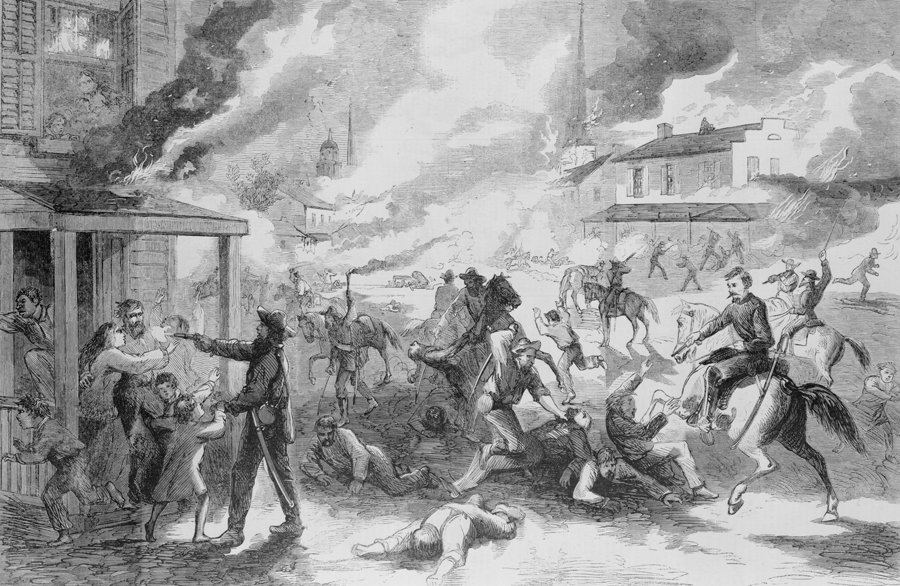About Publications Library Archives
heritagepost.org

Preserving Revolutionary & Civil War History

Preserving Revolutionary & Civil War History

The Civil War was filled with horrors inflicted on both sides that have not been matched before or since in the American story. Perhaps none reach the level of bloodshed, violence, and sheer depravity, however, that took place on Aug. 21, 1863 in Lawrence, Kansas.
Between 160 and 190 men and teenage boys, all civilians and many unarmed, were murdered by Confederate guerillas in a day-long raid that also witnessed the destruction and looting of the town. The man who planned and ordered the massacre was William Quantrill. His guerilla band, known as Quantrill’s Raiders, were not formal members of the Confederate Army. They were Bushwhackers, men who fought against the Union by unconventional means, resorting to robbery and harassing local citizens who did not support the Confederate cause.
To understand how the massacre in Lawrence happened, it’s necessary to step back a few years to the 1854 Kansas-Nebraska Act. After several failed attempts to solve the slavery question, Congress elected to allow each new state that entered the Union to decide by popular sovereignty whether it would be a free state or a slave state.
Kansas was a free state, but people in the neighboring slave state of Missouri had a different idea in mind. Pro-slavery forces crossed the border and attempted to persuade Kansas to vote for slavery. They tried newspaper editorials, rallies, ballot stuffing, and election rigging. When that didn’t work, they resorted to threats, kidnapping, and murder.
The years between 1854-61 were referred to as “Bleeding Kansas.” Acts of violence were committed by Bushwhackers and Jayhawkers alike. Jayhawkers were free-state advocates in Kansas capable of the same level of bloodshed and violence carried out by the Bushwhackers. Every instance of murder or property destruction by one side was answered by a similar act by the other. This tit-for-tat exchange went on so long that the whole affair seemed nothing more than a string of reprisals for previous acts carried out by the opposition.
Quantrill, a drifter before the war with no prospects, took up the Confederate cause and assembled a band of men along the Kansas-Missouri border. Quantrill’s Raiders caused a great deal of havoc for Union troops, and Union General Thomas Ewing, Jr. stepped in to put down the guerilla forces.
In April 1863, Ewing issued a proclamation ordering the arrest of anyone who provided aid and comfort to Quantrill’s men. This led to the arrest of several wives and female relatives of the Raiders. They were placed in a makeshift jail in Kansas City that was previously a home that had undergone recent remodeling.
It turned out that the remodeling was not quality work. This, combined with the housing of too many people in the building made the prison structurally unsound. It collapsed on Aug. 13, killing four women and injuring many others.
Some have pointed to this incident as inciting Quantrill’s raid on Lawrence, but he had been planning it for many days prior. Lawrence, Kan. was the home base of a group of Jayhawkers who harassed Western Missouri civilians and plundered towns and farms to stop the Confederate raids. Quantrill aimed to put an end to their activities. The collapse did, however, infuse his men with a level of bloodlust that may not have otherwise shown itself.
In the early morning hours of Aug. 21, 1863, Quantrill led 450 guerillas into Lawrence. They came upon the town from several directions, cutting off all the roads. They quickly established control of the town, then set out in small groups, systematically looting and burning buildings. They indiscriminately shot anyone who resisted, then as the morning wore on, began rounding up “every man big enough to carry a gun.” Men and teenage boys were shot, bayoneted, scalped, or dismembered. Some hid or escaped into the fields.
The Raiders left Lawrence in the afternoon. All but two businesses in the town had been destroyed. Many homes were burned. Twenty percent of the male population had been murdered, leaving 85 widows and dozens of fatherless children.
Quantrill’s raid only led to more reprisals by the Union and Jayhawkers. In an attempt to track down Frank James, one of the Raiders, Union soldiers found his home and beat his mother and younger brother, Jesse. Jesse James later joined his brother and their friends, the Younger brothers in Quantrill’s ranks. They would continue their reign of terror as bank robbers long after the war ended.
Quantrill continued leading his guerilla band, but their ranks dwindled as the war dragged on. Union forces cut most of their supply lines and killed off several members. Quantrill was shot in the chest during a raid in Kentucky on May 10, 1865 and died in a military prison hospital a month later.